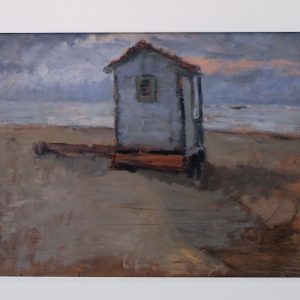L’opera intitolata Ritratto (1927) è esplicativa della cifra stilistica di Marcucci che, a soli diciassette anni ed autodidatta ispirato da Ottone Rosai, ha una maturità artistica in grado di anticipare gli approcci contemporanei al colore, rendendo la materia leggera e filtrata dalla luce. Il mezzobusto di giovane, dipinto con una palette di colori dalle tonalità chiare, si integra perfettamente con lo sfondo; gli occhi azzurri con tocchi di rosa abbinati alla veste, il tono su tono dell’incarnato sullo sfondo rosa e le sfumature integrate tra un volume e l’altro fanno intendere l’espansione dello stesso ritratto sullo sfondo, abbattendo i due piani di percezione. Le forme sono finite e ferme ma lasciano intendere che la natura possa ancora mutarle, offrendo allo spettatore l’impressione di un ritratto volatile e in grado di cambiare costantemente. La ricerca coloristica di Marcucci spazia dallo studio dell’essenza estetica dei soggetti fino alla loro intensa intimità: il ritratto non è inteso in senso letterale ma la figura diventa la rappresentazione umanizzata di uno studio atmosferico che va oltre le forme finite.
Jasmin Prezioso
Storia
Portrait
Mario Marcucci
MARIO MARCUCCI (1910-1992)
Portrait (1927)
Oil on canvas, 27.5×42.5cm
Dino Bargellini Collection
The work entitled Portrait (1927) illustrates Marcucci’s stylistic traits. Only seventeen years old and self-taught and inspired by Ottone Rosai, his artistic maturity anticipated contemporary approaches to colour, making the subject matter lightweight and light filtered. The half-length bust of a young man, painted in a palette of light colours, blends perfectly with the background; the blue eyes with touches of pink matching the dress, the tone on tone of the complexion against the pink background and the shading integrated between one volume and the next suggest the expansion of the same portrait into the background, breaking down the two planes of perception. The forms are finished and stationary but hint that nature can still change them, giving the viewer the impression of a volatile portrait that is constantly changing. Marcucci’s colouristic research ranges from the study of the aesthetic essence of the subjects to their intense intimacy: the portrait is not understood in a literal sense but the figure becomes the humanised representation of an atmospheric study that goes beyond finished forms.
Jasmin Prezioso

